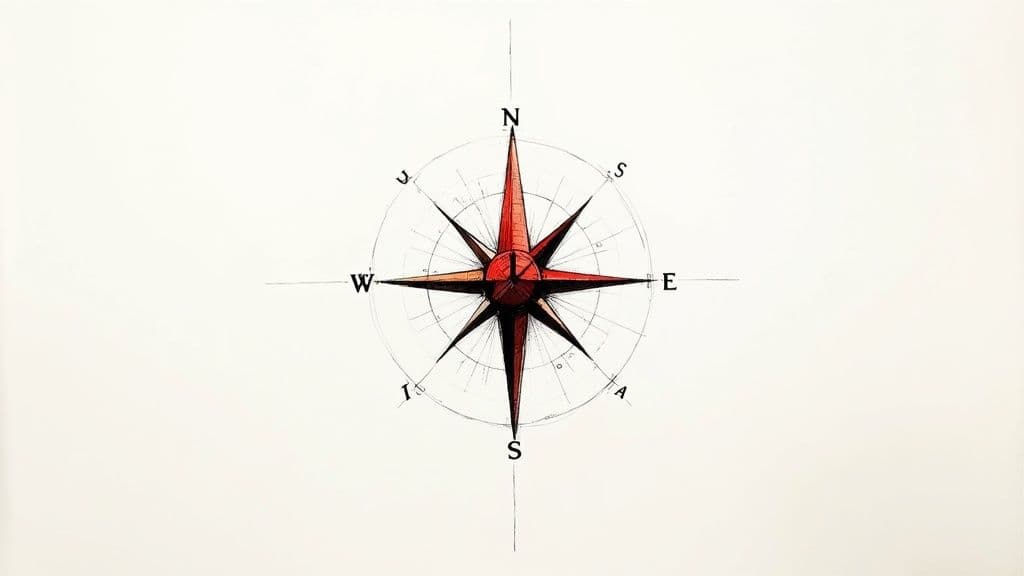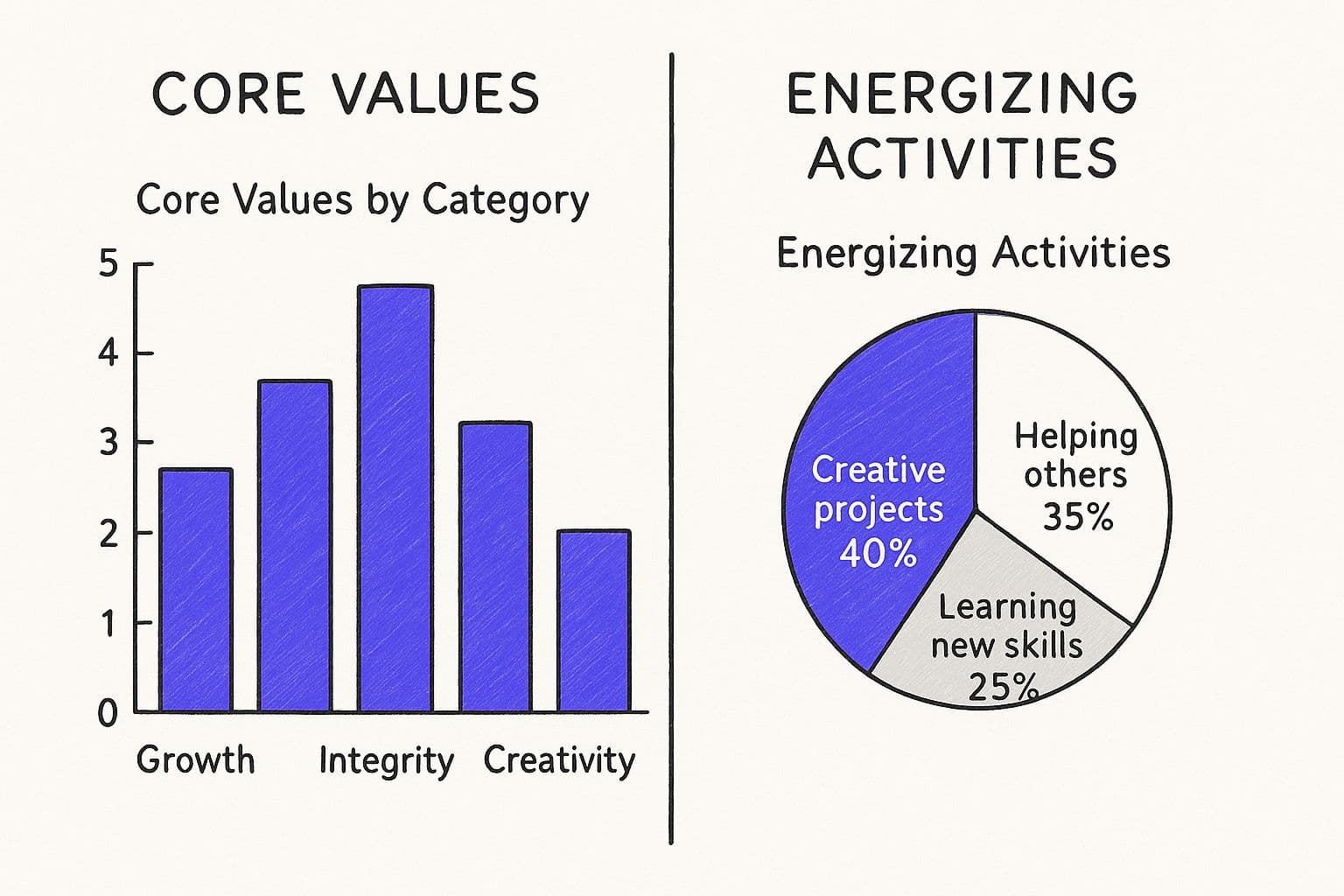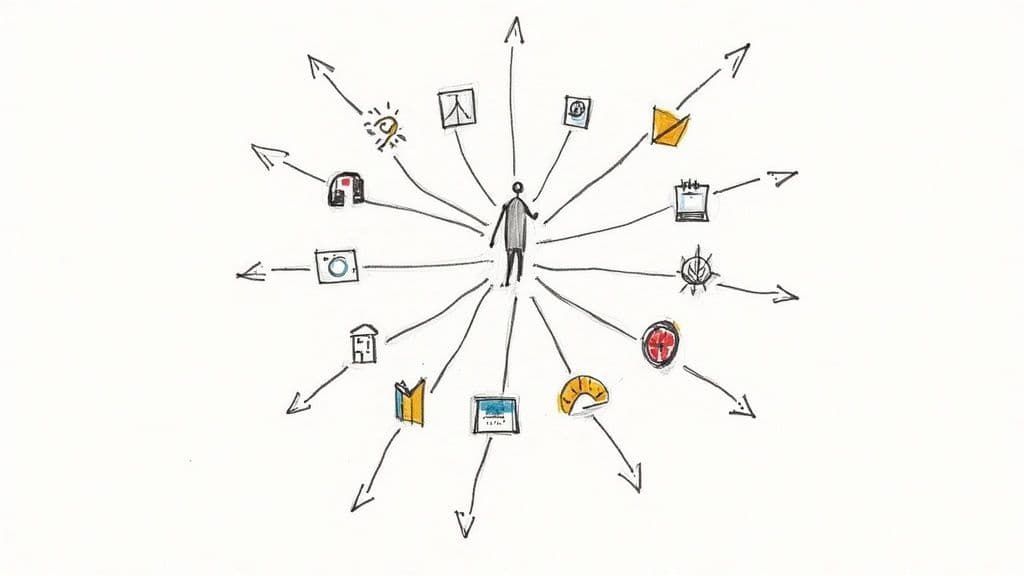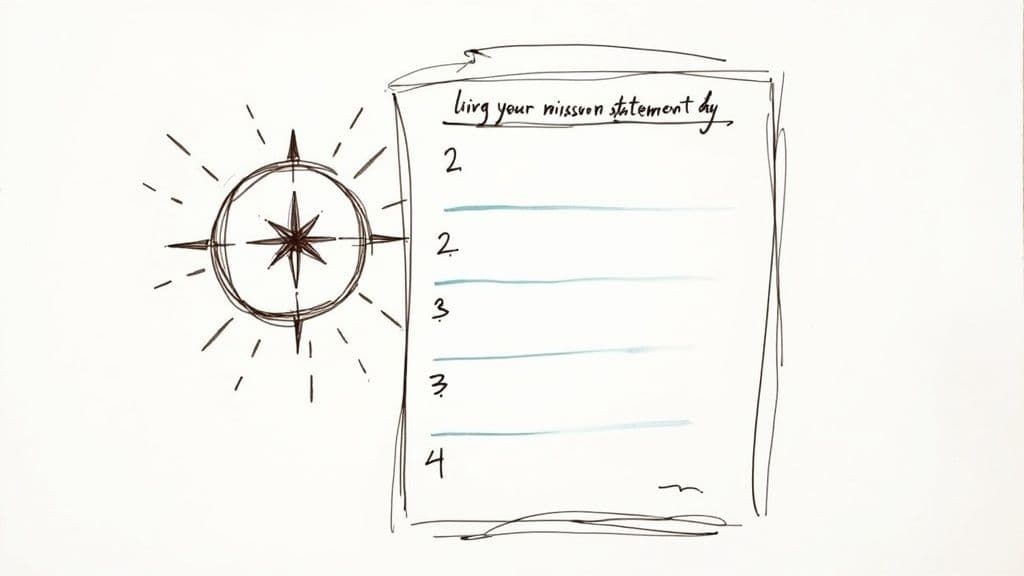How to Write a Personal Mission Statement That Inspires
Learn how to write a personal mission statement with our guide. Discover your values and create a purposeful roadmap for success and fulfillment.

Crafting a personal mission statement is all about digging deep to define your core values, pinpoint what you're truly passionate about, and spell out the unique mark you want to leave on the world.
Think of it as a short, powerful declaration of your purpose: what you do, who you do it for, and why it all matters. It’s less of a corporate slogan and more of a personal constitution for how you make decisions.
Why a Personal Mission Statement Is No Longer Optional
Let's get one thing straight: the idea that a personal mission statement is just some fluffy self-help exercise is completely outdated. In a world where we're all searching for more meaning, it’s become an essential tool for navigating your career and life with real intention.
It's not a tagline—it's your compass. A genuine strategic asset that guides your big decisions, sharpens your focus day-to-day, and helps you bounce back when things get tough.
This isn't just about feeling good; it’s about gaining an almost unfair level of clarity. Once you truly know your 'why,' you can confidently chase the opportunities that actually resonate with you and, just as importantly, say no to the ones that don't.
This kind of clarity delivers some very real benefits:
- Better Career Alignment: You start seeing clearly which roles and companies actually fit your values.
- Higher Engagement: You find a much deeper sense of fulfillment when your daily grind connects to a bigger purpose.
- Increased Confidence: It gives you a solid foundation for making those tough calls, both at work and at home.
The Generational Shift Toward Purpose
This move toward purpose isn't just a personal feeling; it's quickly becoming a professional expectation. Younger generations, especially, are putting a huge emphasis on finding purpose-driven work.

Research has shown that 65% of people aged 25-34 find a brand more interesting if it has a clear mission. Gen Z is even twice as likely as Millennials to believe organizations can actually improve the world. This isn't just talk—it's affecting the job market, with a huge number of people leaving jobs because their values didn't line up with the company's.
A defined mission is what helps you shift from reacting to life to proactively and intentionally living it. It's the difference between just drifting through your career and actually steering it toward a destination you've consciously chosen.
Ultimately, a well-crafted mission statement is the critical first step in managing your priorities effectively. Once you understand your core purpose, you can start building systems that connect your daily tasks to that bigger vision.
With a tool like the Harmony AI app, you can directly link your mission to your weekly plans, making sure that every bit of effort is actually moving you in the right direction. To get started, you can also check out our guide on different priority management systems.
Uncovering Your Core Values and Passions
Before you can write a mission statement, you have to know what actually makes you tick. This isn't about some lofty, abstract ideals; it's about getting brutally honest about your non-negotiables and pinpointing the things that genuinely light you up. A mission statement that actually works is built on this bedrock of self-awareness.
So, let's get started. Grab a notebook or open a new note on your phone. The only rule here is to brainstorm without judgment. Think about what you naturally do in your free time or what problems you can't help but try to solve for people.
To really dig deep and figure out what drives you, learning how to start journaling for self-discovery can be a game-changer for structuring this kind of reflection.
Reflective Questions to Ask Yourself
Carve out some quiet time to really think through your experiences. Don't rush this. The quality of your answers here will directly translate into how authentic—and useful—your mission statement feels.
Ask yourself:
- When do I feel the most like me?
- What topics could I talk about for hours and never get bored?
- What activities make me completely lose track of time?
- What have I done, big or small, that made me feel genuinely proud?
After a good brainstorming session, you can start to categorize what you've written down. You might end up with something that looks a bit like this:

You can see how certain values, like integrity, might pop up a lot, while your real energy comes from specific things like creative projects. It's about spotting those patterns.
Prioritizing What Matters Most
This kind of self-work isn't just a "nice to have" anymore; it's becoming essential in the professional world. Research consistently shows that a fuzzy sense of personal mission leads to dissatisfaction. On the flip side, people who connect their daily work to a deeper purpose report way more fulfillment and are far more likely to be top performers.
Once you know what you stand for, you can start making career choices that actually line up with who you are.
Your core values are the hills you're willing to die on. Your passions are the things that refuel you. You need both for a mission statement that has any real meaning.
When you've got a solid list of your values and passions, start grouping similar ideas together. Then, circle the top 3-5 that hit you in the gut. This part can feel a little messy, but it’s the most important work you’ll do. It lays the entire foundation.
Defining Your Unique Contribution and Impact
Alright, let's get into the heart of it. You've done the hard work of looking inward at your values and passions. Now it's time to turn that focus outward.
This is where your mission statement really comes to life. It’s the part where you connect who you are with the contribution you want to make. Think of it as defining the specific, positive dent you want to put in the universe.
So, What's the Impact You Want to Make?
Don't get intimidated by the word "impact." This isn't necessarily about saving the world (unless that's your genuine calling, which is amazing). For most of us, making a real impact happens on a much more personal scale. It’s felt within our families, our teams at work, our local communities, or our industries.
The key is getting specific about the results you want to create—the things you want to be known for.
To get the wheels turning, ask yourself a few direct questions:
- Who, specifically, do I want to help or empower?
- What problem am I uniquely positioned to solve for them?
- What skills or perspectives do I have that nobody else does?
- If I had a magic wand to change one thing in my line of work, what would it be?
This shift from "me" to "them" is what turns a simple self-description into a powerful declaration of purpose. It’s no longer just about you; it's about your role in relation to others.
Making Your Contribution Tangible
Sometimes, "impact" can feel a bit fuzzy and abstract. It helps to visualize what a contribution actually looks like in the real world. Your unique impact could be through your creative work, an innovation you bring to your field, or the way you build up your community.
There’s no right or wrong answer here. There’s only what feels true to you.
Think of it this way: Your values are the compass, but your desired impact is the destination. It gives your entire journey a clear and meaningful direction.
When you can draw a straight line from your daily tasks to a tangible impact, everything changes. It’s incredibly motivating. Suddenly, even the toughest parts of your job feel purposeful because you know who you're serving and what change you're trying to create. It makes big decisions a lot simpler, too, because you have a clear benchmark for what truly matters.

To help you pinpoint where you want to focus your energy, I’ve put together a few examples. See which of these areas sparks something for you.
Examples of Contribution Focus Areas
This table shows different ways to frame your personal contribution, helping you identify the area that best aligns with your values and passions.
| Focus Area | Guiding Question | Example Statement Snippet |
| Knowledge & Expertise | How can I share what I know to educate or inform others? | "...to demystify complex financial topics for young professionals." |
| Innovation & Creativity | What new ideas, products, or art can I bring into the world? | "...to build elegant software solutions that solve everyday frustrations." |
| Leadership & Mentorship | Who can I guide, support, and help grow? | "...to mentor emerging leaders and help them find their voice." |
| Community & Connection | How can I bring people together or strengthen bonds? | "...to create welcoming spaces where diverse communities can connect." |
| Problem-Solving | What specific challenge or inefficiency can I fix? | "...to streamline operational processes so teams can focus on creative work." |
Looking at these different angles can help you translate your internal drivers—your values and passions—into a clear, actionable impact.
If you’re still struggling to connect the dots, an AI tool like Harmony AI can be a fantastic brainstorming partner. By plugging in your core values, it can help you articulate the unique contribution you want to make, bridging that gap between introspection and a powerful, outward-facing mission.
Crafting Your Mission Statement
Alright, you’ve done the hard work of digging deep—uncovering your core values, your passions, and the kind of mark you want to leave on the world. Now comes the fun part: turning that raw material into a mission statement with some real punch.
This isn't about writing a long, drawn-out essay. We’re aiming for something clear and concise that will act as your personal compass.
The best mission statements are short, easy to remember, and full of active language. They feel right because they're built on the foundational work you've already put in.
Simple Structures to Get You Started
Sometimes, all you need is a good framework to get your thoughts organized. These aren't rigid rules, just starting points. One of the most effective I've seen is this classic formula:
To [Your Contribution] for [Your Audience] so that [The Desired Outcome].
This simple structure forces you to get specific about what you do, who you serve, and the change you hope to create.
For instance, a software developer might land on something like: "To build intuitive tools (contribution) for creative entrepreneurs (audience) so they can bring their ideas to life more easily (outcome)."
Look at how some well-known people have boiled it down:
- Oprah Winfrey: "To be a teacher. And to be known for inspiring my students to be more than they thought they could be."
- Sir Richard Branson: "To have fun in my journey through life and learn from my mistakes."
Notice they’re not trying to be everything to everyone. Each statement is direct, personal, and laser-focused on a core truth. That's the goal.
Overcoming Writer's Block With AI
Even with all your notes in front of you, staring at a blank page can be intimidating. I’ve been there. This is a perfect time to bring in a co-creator. When you’re stuck, sometimes a little tech can bridge the gap between your jumbled ideas and a polished statement.
If you’re struggling to find the right words, the Harmony AI app was designed for exactly this moment.
You can feed it your lists of values, passions, and impact goals, and it will help you articulate and refine those concepts into powerful drafts. It’s like having a brainstorming partner who can cut through the mental fog in seconds, giving you clear, inspiring options to work with. This process can seriously improve work efficiency by getting you to a great result much faster.
In the end, it doesn't matter if you use a framework or get a jumpstart from a tool. What matters is that the final words resonate with you. Read your draft out loud. Does it sound like you? Does it give you a jolt of energy?
When the answer is yes, you know you’re on the right track.
Making Your Mission Statement a Daily Habit
A personal mission statement isn't a trophy to hang on the wall; it's a compass for navigating your life. Crafting it is a massive step, but its real power is unlocked when you turn those words into a practical guide for your daily decisions.
Think of your statement as a filter. When a new opportunity, project, or even a simple request comes your way, hold it up against your mission. Does it fit? Will it push you toward your purpose, or will it pull you off course? This quick mental check-in makes saying "yes" or "no" a whole lot easier.
Your mission statement also becomes the foundation for everything you do, including building a powerful personal brand that truly reflects who you are. This simple practice ensures that your choices—both big and small—add up to a coherent and fulfilling story.

Weave It Into Your Routine
To keep your mission front and center, you have to weave it into your existing habits. It's simple: you can't live by a statement you don't remember.
- Sunday Sit-Down: Set aside a few minutes each Sunday to read your mission statement. Let it shape your intentions for the week ahead.
- Decision Log: When a tough choice pops up, jot down how each potential path aligns with your core mission. It brings incredible clarity.
- Visible Reminders: Put it where you’ll see it every day. Your desk, your phone's lock screen, the first page of your journal—whatever works for you.
This isn't just a feel-good exercise. There are tangible benefits. Research shows that employees who take the time to draft mission statements see real boosts in morale and productivity. For a lot of people, purpose is becoming a non-negotiable part of their career.
A mission statement only has power when it's in motion. Review it, refine it, and let it guide you. It's a living document for a reason—because you are, too.
Ultimately, integrating your mission into daily life takes consistent effort. This is where tools designed for intentional living, like an AI personal assistant app, can make all the difference by connecting your daily plans directly to your deeper purpose. The Harmony AI app is built specifically for this, turning your mission into actionable weekly plans so your daily tasks always align with your biggest goals.
Got Questions About Mission Statements?
As you start to nail down your own mission statement, a few common questions usually pop up. Let's walk through them so you can move forward with a bit more clarity.
How Long Should This Thing Be?
Keep it memorable, not a monologue. The best mission statements are usually just one or two punchy sentences. Think of it as your personal mantra, not a business plan.
If you find yourself writing a whole paragraph, you’re probably getting into the how. Pull back. The real goal is to capture your core why and what. Focus on the impact you want to have, not the specific steps to get there.
How Often Should I Revisit It?
Your mission statement is a living thing because, well, you are a living thing. You're constantly growing and evolving.
I’ve found it’s a great practice to check in with it at least once a year. It's also smart to review it during big life changes—starting a new job, graduating, moving across the country. The point isn't to constantly rewrite it from scratch, but just to make sure it still feels right and points you in the direction you want to go. It should grow with you.
A personal mission statement is your compass for the present—it defines what you do now. A vision statement is your telescope for the future—it describes the world you want to create down the road.
Is It Okay to Have More Than One?
It’s best to stick to one, single overarching mission statement. This is your North Star. Having just one keeps your direction clear and unified, preventing you from feeling pulled in a million different directions.
That said, you can absolutely create specific guiding principles for the different roles you play in life—like for your career, your family, or even a creative side hustle. The key is to make sure these "sub-missions" all support your main one. Think of them as different trails that all lead to the same mountain peak.
Feeling a bit stuck trying to get started? The Harmony AI app was designed to help you cut through that noise. It walks you through a process to uncover your core values and passions, helping you draft an inspiring mission statement that actually feels like you.
Then, Harmony helps you turn that big-picture mission into a practical weekly plan, so your daily actions are always lined up with what matters most. You can get started at https://www.useharmony.com.
"""
Harmony AI Planner
Plan your weeks, plan your life. Define your mission, plan weeks around your roles, and stay on track every day with AI guidance.
Personal Mission
Define your deeper why with a mission statement
Role-Based Planning
Plan weeks around work, family, and personal growth
AI-Powered Guidance
Get goal suggestions and daily nudges to stay on track
Engaging Experience
Celebrate progress with confetti and stay motivated